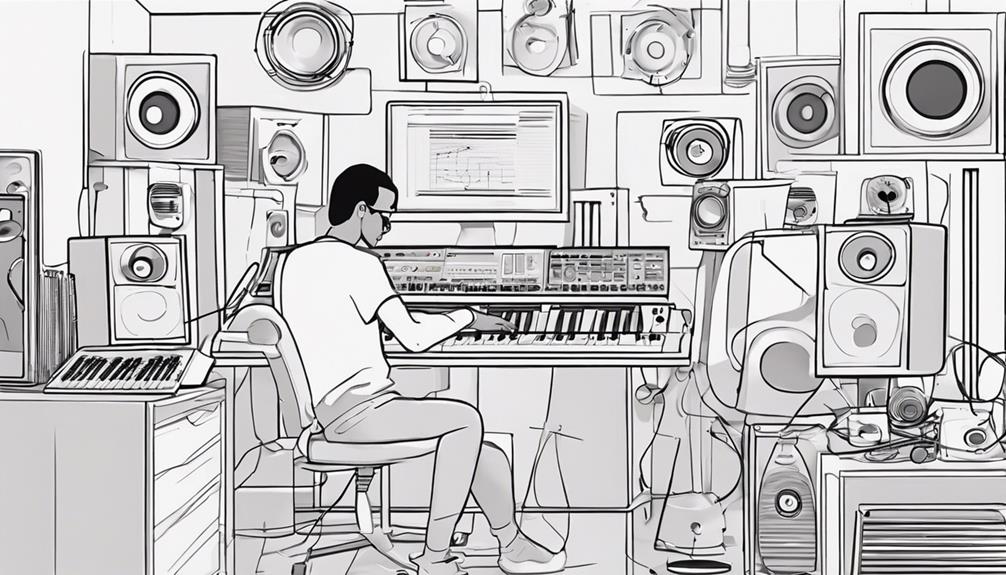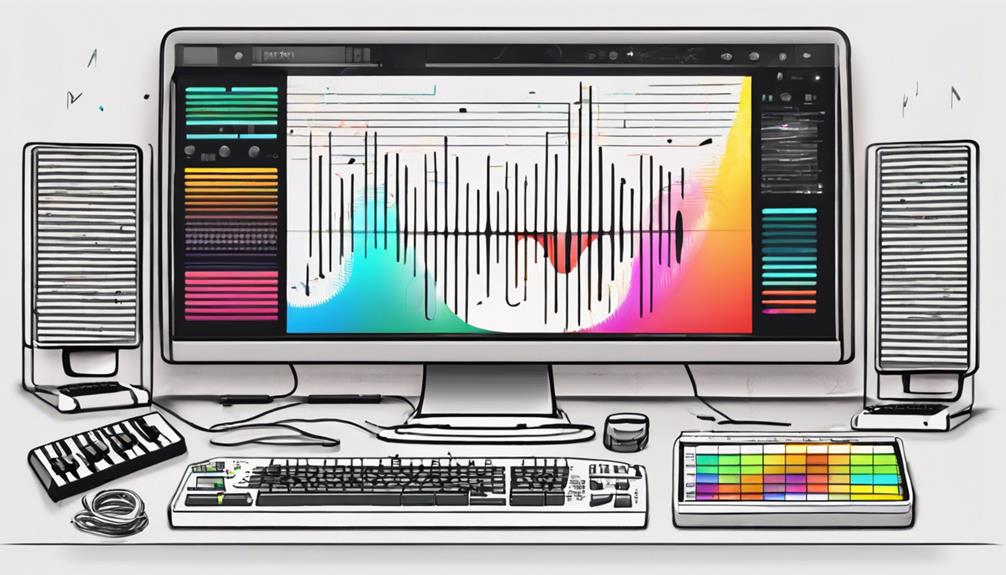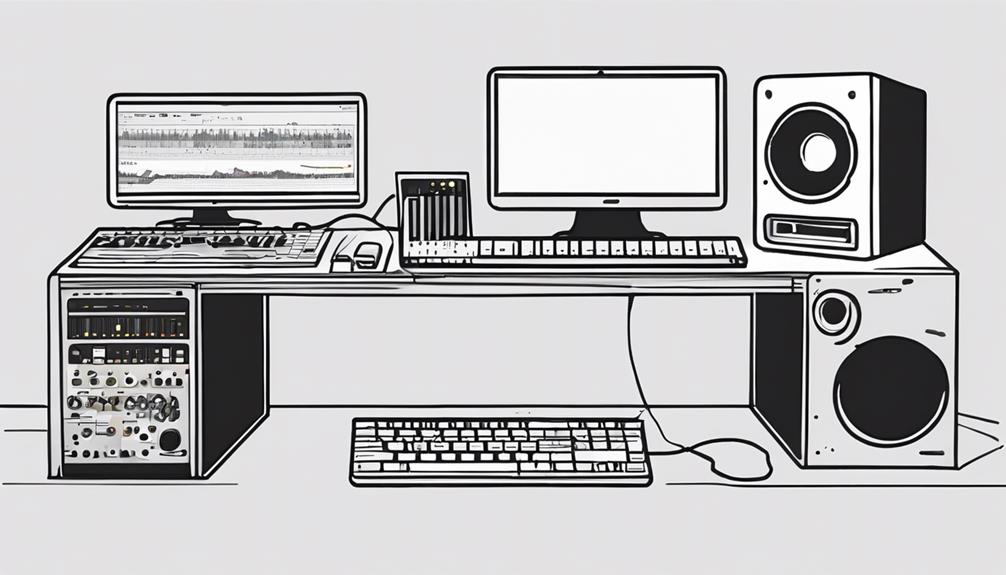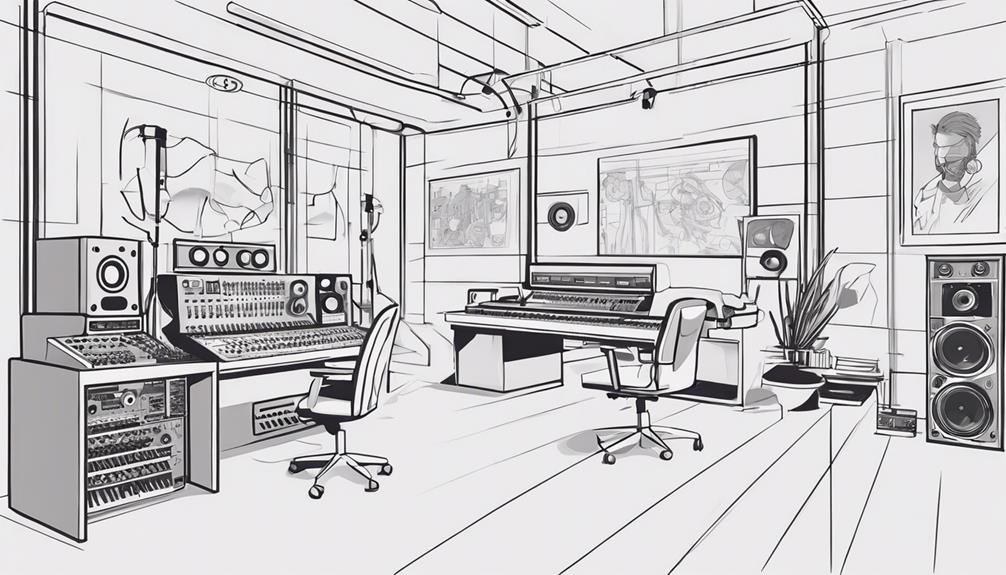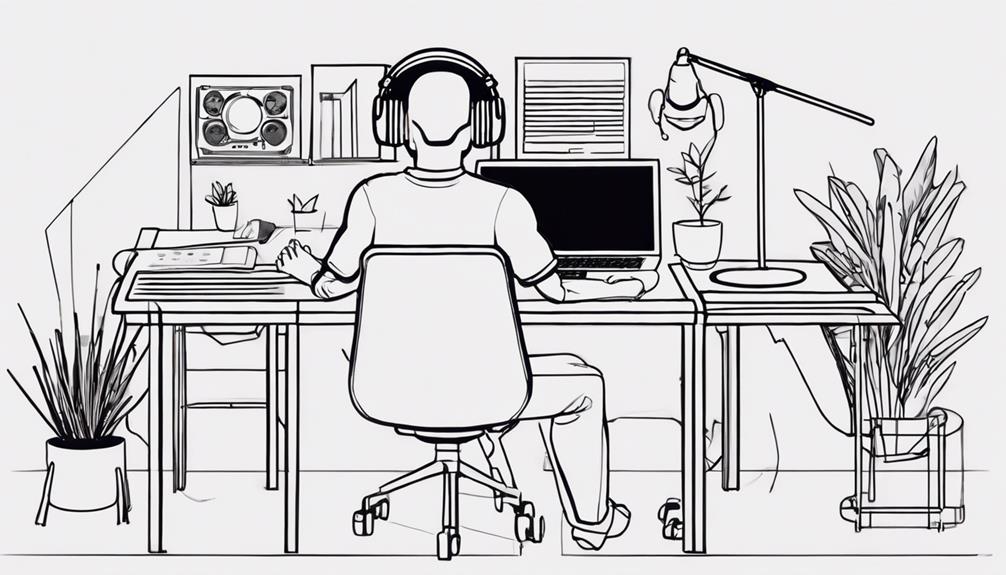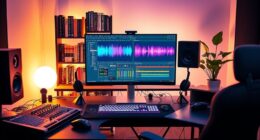To succeed in music production, start by absorbing diverse music and embracing fundamental theory. Focus on mastering your production tools, exploring sound design and mixing techniques, and grasping audio mastering basics. Make practice a habit, streamline your workflow, and balance creativity in compositions. Guarantee your music sounds great across various sound systems. Ready to enhance your skills further? Network with other producers and collaborate to gain fresh perspectives and insights. Remember to train your ears for music by paying close attention to elements like tone, dynamics, and frequency balance in both your work and professional tracks. Stay consistent in refining your craft, and don’t shy away from constructive feedback to keep improving.
Key Takeaways
- Set clear goals and milestones for learning music production.
- Practice consistently and efficiently manage your time.
- Experiment with diverse genres, production techniques, and tools.
- Seek feedback from mentors and peers for improvement.
- Develop a strong foundation in music theory and audio engineering principles.
Listen and Study Diverse Music Genres
Regularly listen to a diverse range of music genres to deepen your understanding of music production techniques and styles. By exploring various genres like rock, hip-hop, electronic, and classical, you can expand your knowledge of production techniques, instrumentation, arrangement, and mixing.
Paying attention to how different genres utilize effects, dynamics, and structure will enhance your own production abilities.
Studying the instrumentation in genres such as rock can teach you about the importance of guitar riffs, drum patterns, and basslines in creating a powerful sound. Analyzing hip-hop tracks can provide insights into the use of sampling, beat-making, and vocal arrangements.
Electronic music genres offer a wealth of knowledge on synthesizers, sound design, and intricate mixing techniques. Classical music can introduce you to orchestration, complex arrangements, and the art of creating dynamic compositions.
Embrace Music Theory Fundamentals
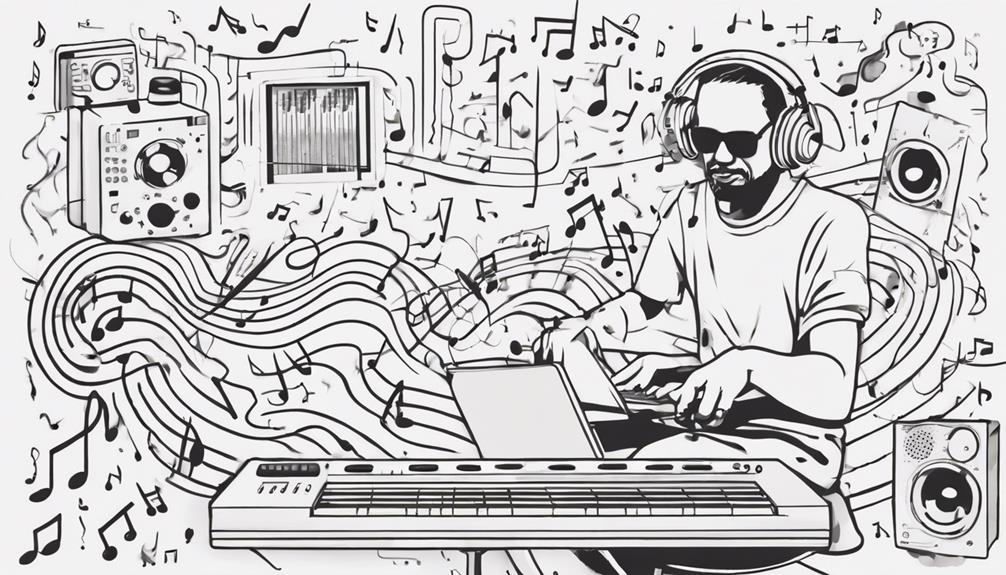
To enhance your understanding of music production, it is important to embrace the fundamentals of music theory. Music theory serves as the backbone of your compositions, providing a solid framework for your creative endeavors. By delving into concepts such as notes, scales, chords, and rhythm, you can elevate the quality and depth of your music production skills. Here is a breakdown of how these fundamental elements of music theory play a vital role in your journey:
| Element | Description | Importance |
|---|---|---|
| Notes | Building blocks of music, representing pitch | Essential for melody creation |
| Scales | Patterns of notes that create a specific sound | Establish the tonal palette |
| Chords | Combination of notes played together harmoniously | Form the harmonic structure |
| Rhythm | The pattern of beats and timing in music | Drives the pace and energy |
Understanding these core aspects of music theory will not only enhance your ability to create engaging compositions but also provide a strong foundation for mastering your production tools effectively.
Master Your Production Tools

Getting acquainted with your Digital Audio Workstation (DAW) is essential for effectively exploring and utilizing its features in music production. Your DAW serves as the central hub for your creative process, allowing you to arrange, mix, and master your tracks efficiently.
Additionally, learning about various plugins and effects can greatly enhance your production capabilities and spark new creative ideas. Experimenting with different production tools such as MIDI controllers, synthesizers, and drum machines can help diversify your sound and add unique elements to your music.
Mastering the art of sound design is vital for creating innovative and distinctive sounds that set your productions apart from the rest. By staying up to date with advancements in production tools and technology, you can continuously improve your skills and remain competitive in the ever-evolving music industry.
Establish Consistent Practice Habits
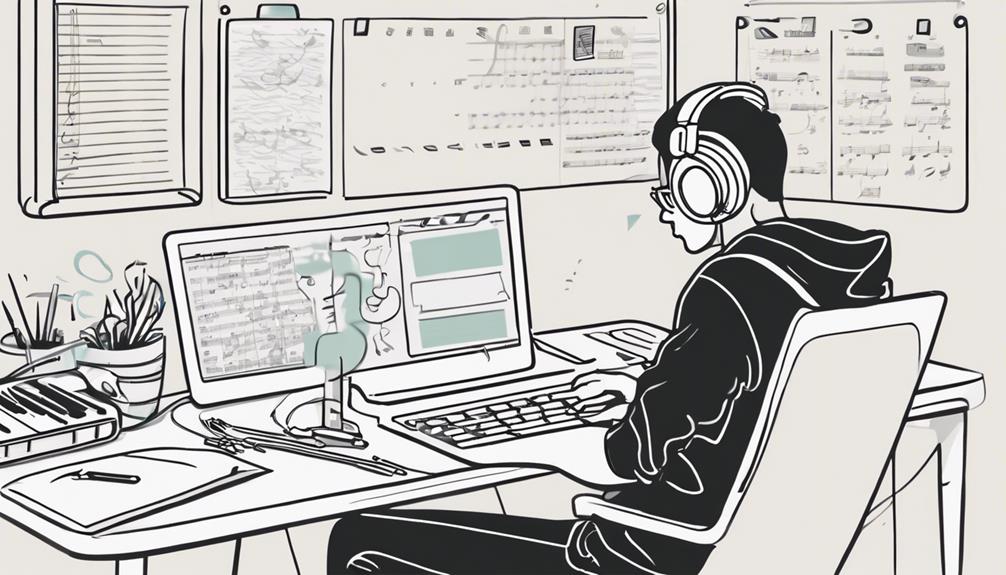
To succeed in music production, you must commit to practicing consistently every day. Develop a structured routine that allows you to focus on different skills and set clear goals for each session to track your progress effectively.
Daily Practice Routine
Establishing consistent daily practice habits is essential for improving your music production skills. To make the most of your practice sessions, consider the following tips:
- Dedicate a specific time each day: Setting aside dedicated time for music production practice helps you establish a routine and guarantees you consistently work on honing your skills.
- Set achievable goals: By outlining clear objectives for each practice session, you can stay motivated and focused. These goals can range from mastering a specific technique to completing a small project.
- Utilize online tutorials and courses: Online resources are valuable tools for guiding your practice and expanding your knowledge. Whether you're learning a new software or exploring different production techniques, online tutorials can offer valuable insights.
Time Management Strategies
Dedicate consistent daily time to your music production practice to establish effective time management strategies. Setting aside specific blocks for practice sessions in your routine can help you stay organized and committed to honing your skills.
Use tools like calendars or apps to schedule your practice sessions and monitor your progress. Breaking down your practice sessions into smaller tasks can make them more manageable and help you maintain focus.
Prioritize regular, shorter practice sessions over long, sporadic ones to improve skill development and retention. Experiment with various practice techniques to discover what works best for your learning style and fits into your schedule seamlessly.
Enhance Workflow Efficiency

To enhance your music production workflow, focus on streamlining your process, optimizing your software usage, and implementing effective time management strategies.
By organizing your workspace and creating efficient templates in your DAW, you can save time and work more productively.
Utilizing MIDI controllers and sound design techniques will further enhance your efficiency and help you achieve a higher quality of production.
Streamline Music Production
Enhance your music production workflow efficiency by optimizing your workspace and utilizing customized DAW templates.
When aiming to streamline music production, consider the following tips:
- Utilize MIDI Controllers: Incorporate MIDI controllers into your setup to have real-time control over software instruments and effects, allowing for a more tactile and intuitive music-making experience.
- Master Sound Design Basics: Understanding sound design fundamentals is essential for crafting unique sounds efficiently. By grasping the basics, you can enhance your workflow and bring your creative visions to life more effectively.
- Develop Presets for Effects: Save time and boost productivity by creating presets for commonly used effects and instruments in your DAW. Having these presets readily available will expedite your production process and allow for more seamless experimentation with different sounds.
Optimize Software Usage
To streamline your workflow and enhance efficiency in music production, optimizing your software usage is imperative. Utilize keyboard shortcuts and custom key bindings in your music production software to speed up tasks like editing, mixing, and arranging.
Organize your project files and samples systematically within your music production software to access them quickly during production sessions. Creating custom templates for different genres or project types can also save you time setting up sessions and help you maintain a consistent workflow.
Efficiently use virtual instruments and plugins by familiarizing yourself with their features and shortcuts for quicker navigation and sound design. Additionally, remember to regularly update your music production software and plugins to benefit from new features and improvements that can enhance your music production process.
Time Management Strategies
Implementing effective time management strategies can greatly enhance workflow efficiency in music production. To make the most of your time and boost productivity, consider the following tips:
- Create a detailed schedule: Allocate specific time for each production task to maximize productivity. By breaking down your work into manageable chunks with dedicated time slots, you can stay focused and on track.
- Utilize project management tools: Stay organized by using apps or calendars to track progress and deadlines effectively. These tools can help you prioritize tasks, set reminders, and make sure nothing falls through the cracks.
- Implement time-blocking techniques: Dedicate uninterrupted periods for specific production activities. By time-blocking, you can boost concentration and efficiency, ensuring that you make significant progress in each session.
Prioritize tasks based on importance and deadlines to make sure timely completion of projects, ultimately helping you achieve your music production goals efficiently.
Explore Sound Design Techniques
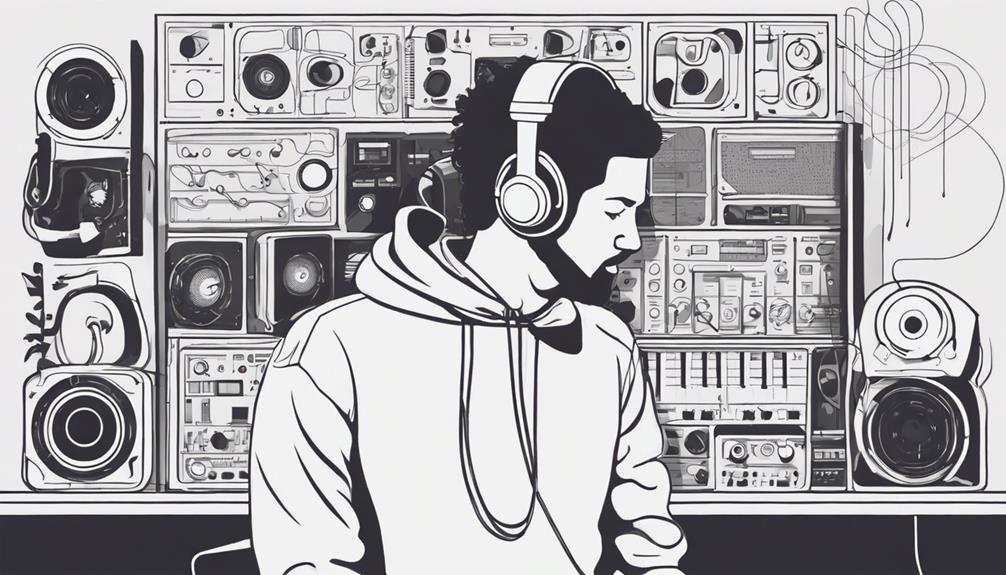
Immersing yourself in re-amplification techniques can greatly enhance the richness and depth of your sound palette in music production. By creatively utilizing white noise, injecting excitement and energy into your compositions becomes effortless.
Synthesized sounds can be printed to audio, allowing for further manipulation and customization in your sound design process. Engaging in creative experimentation by breaking traditional rules in sound design can ignite innovation and lead to unique music productions.
Embrace the opportunity to explore new sonic possibilities through working with audio in sound design, enabling endless experimentation and creative exploration. Remember, pushing the boundaries and thinking outside the box are key to developing your signature sound.
Embrace the freedom to experiment and play with different techniques, as this is where true creativity flourishes. Delve into the world of sound design with an open mind and a willingness to explore, and you'll be amazed at the unique textures and atmospheres you can create.
Balance Variation and Repetition
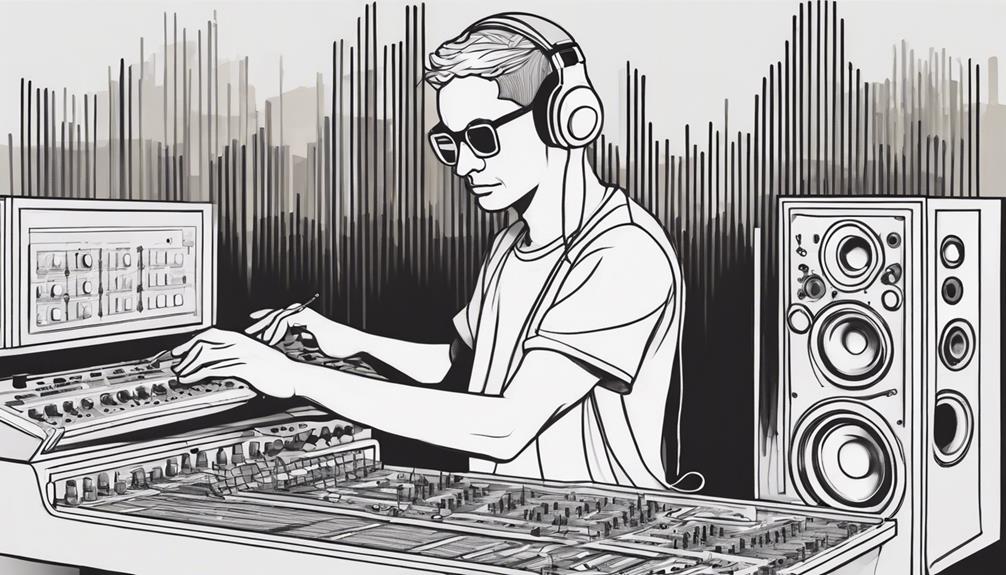
When creating music, remember to strike a balance between variation and repetition.
By incorporating rhythmic patterns for variety and utilizing looping techniques for cohesion, you can keep your listeners engaged while maintaining a sense of continuity.
Experiment with different ways to introduce both elements in your music to achieve a dynamic and memorable sound.
Rhythmic Patterns for Variety
To maintain an enchanting and intriguing rhythm in your music production, blend a mix of varied rhythmic patterns that balance both repetition and novelty.
When exploring rhythmic patterns for variety, consider the following:
- Experiment with Varied Rhythms: Incorporating diverse rhythmic patterns keeps your music fresh and engaging, holding the listener's attention throughout the song.
- Play with Different Time Signatures and Tempos: Changing time signatures and tempos adds depth and complexity to your compositions, creating a dynamic listening experience for your audience.
- Enhance Emotional Impact: Strategic use of rhythmic changes can intensify the emotional impact of your music, evoking different feelings and responses from your listeners.
Mastering rhythmic patterns not only enhances the overall quality of your tracks but also allows you to craft music that resonates deeply with your audience.
Looping Techniques for Cohesion
Utilizing looping techniques effectively in music production involves skillfully balancing variation and repetition to create a cohesive and engaging listening experience for your audience. Loops serve as foundational elements that, when manipulated thoughtfully, can elevate the overall quality of your tracks. By introducing variation within loops through subtle changes or layering different sounds, you can keep your music dynamic while ensuring a sense of cohesion throughout.
Essential, on the other hand, plays a vital role in establishing familiarity and maintaining a consistent groove or motif that listeners can latch onto.
In music production, finding the right equilibrium between varying your loops and incorporating repetition is paramount for crafting memorable pieces. Too much repetition can lead to predictability, while excessive variation might result in a disjointed composition. Striking a balance between these elements is key to creating music that's both engaging and coherent, providing your audience with a satisfying listening experience that resonates long after the song ends.
Test Music Across Sound Systems
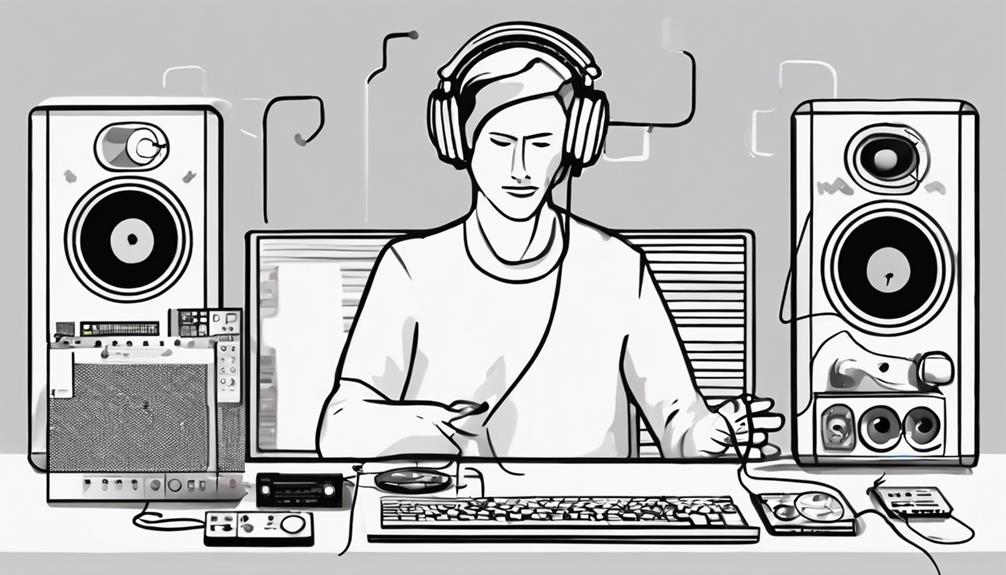
Consider testing your music on a range of sound systems to guarantee consistency and quality across different playback devices. When it comes to ensuring your music sounds great no matter where it's played, here's what you should keep in mind:
- Varied Sound Systems: Experiment with different sound systems like car stereos, studio monitors, headphones, and portable speakers to uncover how your music translates across diverse setups.
- Balanced Mixes: Testing your music on various sound systems can help you achieve balanced mixes by identifying any discrepancies in levels or frequencies that need adjustment.
- Consistent Quality: By regularly checking your mixes on different playback devices, you can maintain a consistent level of quality throughout your production, ensuring a professional and polished final product.
Understanding how your music resonates across a spectrum of sound setups is essential for delivering a high-quality listening experience to your audience. So, don't skip this step in your music production journey!
Dive Into Mixing Techniques
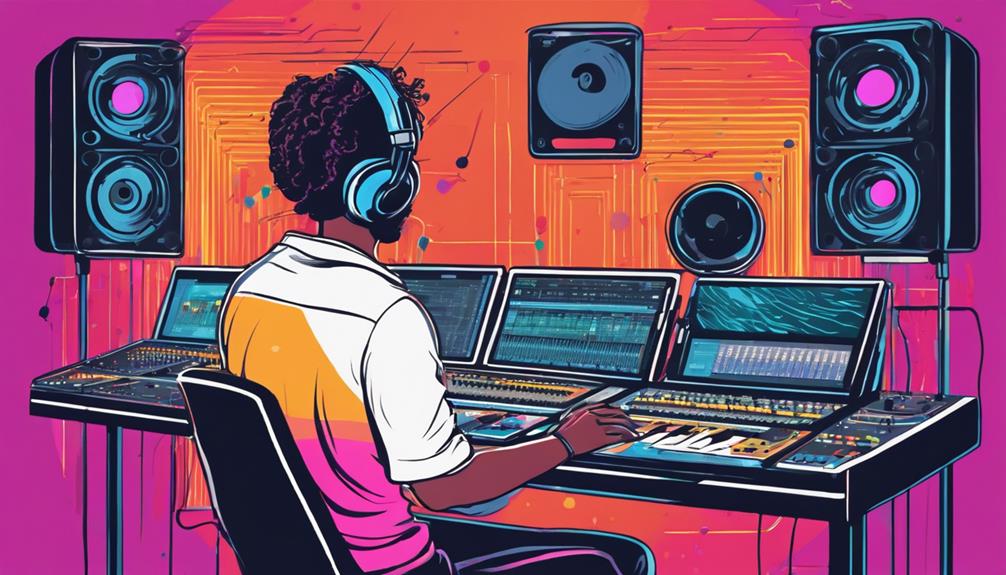
Immerse yourself in essential mixing techniques such as EQ, compression, and reverb to elevate the quality of your music production. Understanding how to manipulate EQ allows you to sculpt the frequency spectrum, carving out space for each instrument.
Compression helps control dynamics, ensuring a more balanced mix by reducing peaks and boosting quieter sounds. Reverb adds depth and space to your tracks, creating a sense of environment and cohesion.
To enhance your mixes further, explore techniques like panning and stereo imaging to create dimension and separation between elements. Experiment with different workflows and tools to discover what suits your style best.
Utilize automation to introduce movement and dynamics, breathing life into your music. Remember to master the art of balancing levels, frequencies, and effects to achieve a polished and professional sound. By honing these mixing skills, you can take your music production to the next level.
Understand Audio Mastering Basics

Mastering audio is the ultimate essential step in perfecting your music production, ensuring your tracks are polished and ready for distribution. When diving into audio mastering basics, remember these key points:
- Enhancing Sound Quality: Audio mastering involves fine-tuning your tracks to achieve excellent sound quality, making them sound professional and cohesive across different playback systems.
- Adjusting Dynamics: Mastering includes fine-tuning the dynamics of your music, ensuring that softer and louder parts are balanced for a smooth listening experience.
- Utilizing Specialized Tools: Mastering engineers use specialized tools like compressors, EQs, limiters, and meters to enhance the audio quality and achieve the desired final sound for your tracks.
Understanding these fundamental aspects of audio mastering is important for producing high-quality music releases that stand out in today's competitive music industry.
Take the time to learn and master these techniques to elevate your music production skills and create impactful tracks.
Frequently Asked Questions
How to Become Successful as a Music Producer?
To become successful as a music producer, you need a deep love for music, strong industry relationships, a unique production style, a clear vision of success, and a commitment to constant growth. Embrace these keys to achieve success.
How Should I Learn Music Production?
To learn music production, start by enrolling in online courses or attending workshops. Collaborate with peers, experiment with different genres and equipment, and join online communities for support. Through these steps, you'll enhance your skills and network effectively. Additionally, dedicating time to understanding digital audio workstations (DAWs) and practicing basic audio editing techniques is crucial. For those wondering how to start music production, it’s essential to begin with affordable equipment and gradually expand your setup as you gain experience. Remember, consistency and creativity are key to developing your unique sound and standing out in the music industry.
How Can I Get Good at Music Production Fast?
To get good at music production fast, focus on essential skills like music theory, sound design, mixing, and mastering. Use online resources, practice regularly, set goals, collaborate with others, and stay updated on industry trends and software updates for rapid improvement.
How I Taught Myself Music Production?
You taught yourself music production by immersing in online tutorials, experimenting with software and hardware, and setting practice goals. Combining theory with hands-on experience helped you develop a solid foundation and enhance your skills.
Conclusion
Now that you have the tools and knowledge to immerse yourself in music production, let your creativity flow like a river!
Mix and match genres like a DJ spinning records, master your tools like a painter with a palette, and fine-tune your sound like a sculptor shaping clay.
With practice and dedication, you'll be a music production maestro in no time.
Keep exploring, experimenting, and creating your own unique sound!


